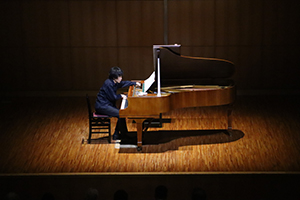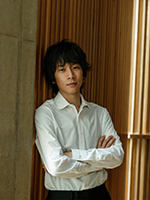No.sfa0056
2023/3/29
- Culture / Sports
“Kitamura Tomoki Piano Recital
- Piano works in 20th century, John Cage / Japanese composers”
announced winning performance of the 22nd Keizo Saji Prize for 2022
Download PDF
 |
 |
 |
|
Kitamura Tomoki Piano Recital |
Kitamura Tomoki×John Cage |
Tomoki Kitamura |
The Suntory Foundation for the Arts (Directors General: Tsuyoshi Tsutsumi and Shingo Torii) has announced that the 22nd (2022) Keizo Saji Prize, bestowed on candidates selected from among those who gave predominantly music-based public performances held in Japan during the year, with winner chosen based on a willingness to challenge and on superior performance that engender a strong reaction, has been awarded to “Kitamura Tomoki Piano Recital - Piano works in 20th century, John Cage / Japanese composers”.
▽Selection process
A qualifying round was held on Sunday, February 12, 2023 at the conference room of the foundation to consider applicants who had given public performances in 2021. After careful consideration, “Kitamura Tomoki Piano Recital - Piano works in 20th century, John Cage / Japanese composers” was chosen as the recipient of the 22nd (2022) Keizo Saji Prize, a decision that received the formal agreement of the Board of Directors of the Foundation on Monday, March 27, 2023.
▽Prize-money ¥2,000,000
▽The members of the selection committee
Seiji Choki, Atsuya Funaki, Nobuhiro Ito, Seiko Ito, Morihide Katayama, Mikako Mizuno, Yoshihiko Nonomura, Miyuki Shiraishi (In alphabetical order)
▽Reason for the award
The concert “Kitamura Tomoki Piano Recital - Piano works in 20th century, John Cage / Japanese composers” comprised two performances. One, performed on October 9 at the ensamble hall of the Biwako Hall Center for the Performing Arts, Shiga was entitled “Kitamura Tomoki Piano Recital - Piano works of Japanese composers in 20th century” The other, a related program held on October 8 in the entrance lobby of the Shiga Museum of Art, was entitled “Tomoki Kitamura×John Cage.” While the main concert was the performance at Biwako Hall Center, for Kitamura, the latter concert featuring all of Cage’s Sonatas and Interludes for Prepared Piano may have had an interactive relationship with the Japanese piano works that transcended time and space.
It began with Toru Takemitsu’s Lento in Due Movimenti, and continued with Kazuo Fukushima’s SUIEN; Minao Shibata’s Improvisation for Piano No. 2; Yoshio Hachimura’s Meditation Higan-Bana; Teizo Matsumura’s Deux Berceuses à la Grèce; and Sesshu Kai’s Music for Piano, before concluding with Maki Ishii’s Black Intention III op.31. Focused primarily on works from the 1960s and 70s, the concert incorporated a truly wide variety of styles and ideas, including in the encore, where Kitamura performed Yuji Takahashi’s The Auroras of Autumn Canto I. Not many pianists in the 21st century would be capable of putting together such a program of piano works by composers who, with the exception of Takahashi, are all deceased. Kitamura's performances were also completely different from the way the pieces had frequently been performed during their composers’ lifetimes. The works sounded fresh and new, as if they had been reinterpreted from a purely modern perspective, having been transformed over the course of time while still allowing us to get a real sense of the invisible folds of history behind them. Going beyond the ideas behind the pieces at the time they were composed, they were given new life, allowing listeners to witness the instant of their bridging to immortality.
Onstage for the Ishii piece, Kitamura made preparation of the piano (inserting screws and bits of rubber between the strings to create a distinctive sound) seem a part of the performance. The concert had a powerful impact on the audience, as if Kitamura were depicting his own dense universe without allowing the introspective, intense mood to be interrupted.
The related program of John Cage works was held in an open space with people freely going in and out, but for each piece as many as 100 people gathered to listen from different directions, and not one of them tried to leave. The careful preparation of the piano was thus itself part of his interpretation of the work, and part of the performance. Kitamura’s clear and at the same time deep touch clearly depicted this lengthy work, and particularly in the second half, one could sense his focus on the performance increase in intensity. This contemplative performance could only have come out of Japan as it is in this specific point in time, and here as well, the universe created by Kitamura completely captivated his audience.
(Seiji Choki & Nobuhiro Ito, Committee Member)
▽Outline
Title:Kitamura Tomoki Piano Recital - Piano works of Japanese composers in 20th century
Date:9th October 2022, 15:00
Venue:Ensemble Hall, BIWAKO HALL
Program:
Toru Takemitsu / Lento in Due Movimenti (1950)
Kazuo Fukushima / SUIEN (1972)
Minao Shibata / Improvisation for Piano No.2 no.31(1968)
Yoshio Hachimura / Meditation higan-bana (1969)
Teizo Matsumura / Deux Berceuses à la Grèce(1969)
Sesshu Kai / Music for piano (1974)
Maki Ishii / Black Intention III op.31(1977)
Artists:Tomoki Kitamura, Piano
Organized by BIWAKO HALL Center for the Performing Arts, Shiga
(Related program)
Title:Kitamura Tomoki × John Cage
Date:8th October 2022, 11:00/14:00
Venue:Entrance Lobby, Shiga Museum of Art
Program:John Cage / Sonatas and Interludes for Prepared Piano (1946-48)
Artists:Tomoki KitamuraIchiro, Piano
Organized by BIWAKO HALL Center for the Performing Arts, Shiga
Co-organized by Shiga Museum of Art
See here for more on the Keizo Saji Prize
See here about the Suntory Foundation for the Arts
